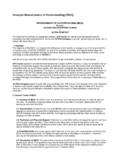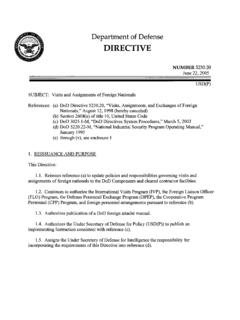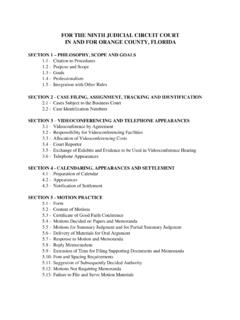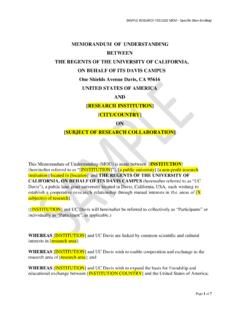Transcription of Charitable Companies: Model Articles of Association (GD1)
1 AUGUST 2014 New format January 2017 Charitable Companies: Model Articles of AssociationNotes1 Model memorandum and Model Articles of Association for a Charitable CompanyA charity may need to take the form of a company when there is a risk that it might incur large financial liabilities because, for example, it is expected to: control substantial assets; or employ staff; and/or engage in Charitable purposes involving commercial to consider before you beginYou may find it helpful to begin by reading the following guidance on our website: The comprehensive information under Start up a charity Registering as a Charity (CC21). Its checklist of questions will help you todecide how best to set up the charity. Annex A summaries the nature ofthe responsibilities of those who run the charity, both as charity trusteesand as company directors (in this document we use the term directors ).
2 Choosing and Preparing a Governing Document (CC22). This gives adviceon the practicalities of completing the charity s governing document andon the different provisions which may be needed. Our guidance The Essential Trustee - What you need to know (CC3), whichsets out the basics that all charity trustees need to steps1. Completing the Articles of associationOnce you have decided to apply to register a Charitable company, please read the Articles of Association and its accompanying guidance notes Articles contain blank spaces that you will need to fill Model is intended to be sufficiently flexible to deal with most eventualities. If you want to include special or complex provisions which are not contained in it you should consider asking a solicitor to help you.
3 Please make clear any changes you make and why they are necessary. This will help us to consider your application as quickly as possible. We cannot guarantee to accept every organisation which uses the Model Articles of Association as Charitable . We must consider each case you have completed this document please check that you have filled in all the gaps and deleted any Articles which are not Applying to register as a companyYou will need to apply to Companies House to incorporate your organisation. Companies House will then issue you a certificate of incorporation. For details please visit the Companies House Applying to register as a charityTo register a new charity apply online. If you cannot apply online, please contact us using the link from our website How long will it take?
4 We can normally make a decision in 15 working days if an organisation: uses our Model wording for its objects (as set out in the Examplecharitable objects on our website); shows that its activities are or will be consistent with the objects; shows that any private benefit is incidental and is properly managed; and uses our Model governing applications will need closer consideration and so will take longer (especially where the purposes are novel and/or at the boundaries of what is Charitable ).Please note that if you want to include any special or complex provisions which are not contained in the Model Articles of Association you should consider asking a solicitor to help you. We may require more time to consider any such specialist changes.
5 It is important to make clear what changes you Commission cannot guarantee that a proposed organisation which uses a Model as its governing document will be accepted as Charitable . Every case has to be considered NOT HAVING A SHARE CAPITALA rticles of Association for a Charitable Company Articles of Association of ..1 The company s name is ..(and in this document it is called the charity ).Interpretation2 In the Articles : address means a postal address or, for the purposes of electronic communication, a fax number, an e-mail or postal address or a telephone number for receiving text messages in each case registered with the charity; the Articles means the charity s Articles of Association ; the charity means the company intended to be regulated by the Articles ; clear days in relation to the period of a notice means a period excluding: the day when the notice is given or deemed to be given; and the day for which it is given or on which it is to take effect; the Commission means the Charity Commission for England and Wales.
6 Companies Acts means the Companies Acts (as defined in section 2 of the Companies Act 2006) insofar as they apply to the charity;These explanatory notes are for advice and reference only and in no way form part of the text of the Articles of about the requirements of the Companies Act 2006 are available from Companies House and our website company nameArticle 1 - Insert company name. In general, the Commission can accept any name but has the power to direct registered charity names to be changed in the circumstances set out in section 42(2) of the Charities Act 2011, which are explained in our guidance Registering as a Charity (CC21) and in our Operational Guidance Names of charities available on our website.
7 In very broad terms, the name should not be offensive, or identical to (or too like) the name of any other charity, or likely to mislead the public about its purposes, activities, status, or 2 - The Articles include reference to a company secretary. Having a company secretary is no longer a legal requirement. Accordingly, the references to the company secretary are such that the charity can operate without one if it wishes to do so. Apart from the definition of secretary and officers in this interpretation article, there are also references to the secretary in Articles , 41(3) and article the directors means the directors of the charity. The directors are charity trustees as defined by section 177 of the Charities Act 2011; document includes, unless otherwise specified, any document sent or supplied in electronic form; electronic form has the meaning given in section 1168 of the Companies Act 2006; the memorandum means the charity s memorandum of Association ; officers includes the directors and the secretary (if any); the seal means the common seal of the charity if it has one; secretary means any person appointed to perform the duties of the secretary of the charity; the United Kingdom means Great Britain and Northern Ireland.
8 Andwords importing one gender shall include all genders, and the singular includes the plural and vice the context otherwise requires words or expressions contained in the Articles have the same meaning as in the Companies Acts but excluding any statutory modification not in force when this constitution becomes binding on the from the exception mentioned in the previous paragraph a reference to an Act of Parliament includes any statutory modification or re-enactment of it for the time being in of members3 The liability of the members is limited to a sum not exceeding 10, being the amount that each member undertakes to contribute to the assets of the charity in the event of its being wound up while he, she or it is a member or within one year after he, she or it ceases to be a member, for:(1) payment of the charity s debts and liabilities incurred before he, she or it ceases to be a member;(2) payment of the costs, charges and expenses of winding up; and(3) adjustment of the rights of the contributories among The charity s objects ( Objects ) are specifically restricted to the following.
9 [Nothing in the Articles shall authorise an application of the property of the charity for purposes which are not Charitable in accordance with section 7 of the Charities and Trustee Investment (Scotland) Act 2005 and/or section 2 of the Charities Act (Northern Ireland) 2008.]Powers5 The charity has power to do anything which is calculated to further its Object(s) or is conducive or incidental to doing so. In particular, the charity has power:(1) to raise funds. In doing so, the charity must not undertake any taxable permanent trading activity and must comply with any relevant statutory regulations;(2) to buy, take on lease or in exchange, hire or otherwise acquire any property and to maintain and equip it for use;(3) to sell, lease or otherwise dispose of all or any part of the property belonging to the charity.
10 In exercising this power, the charity must comply as appropriate with sections 117 and 122 of the Charities Act 2011.(4) to borrow money and to charge the whole or any part of the property belonging to the charity as security for repayment of the money borrowed or as security for a grant or the discharge of an obligation. The charity must comply as appropriate with sections 124 - 126 of the Charities Act 2011 if it wishes to mortgage land;Article 4 - The Articles of a non- Charitable company are not required to have objects. However, a Charitable company s Articles must specifically restrict the company to only furthering Charitable the purpose(s) for which the company has been formed. A charity s objects must be expressed in exclusively Charitable terms.














